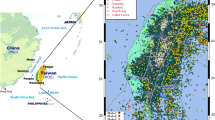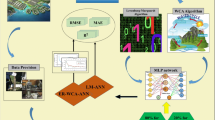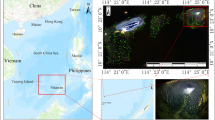Abstract
Surface wave inversion is a key step in the application of surface waves to soil velocity profiling. Currently, a common practice for the process of inversion is that the number of soil layers is assumed to be known before using heuristic search algorithms to compute the shear wave velocity profile or the number of soil layers is considered as an optimization variable. However, an improper selection of the number of layers may lead to an incorrect shear wave velocity profile. In this study, a deep learning and genetic algorithm hybrid learning procedure is proposed to perform the surface wave inversion without the need to assume the number of soil layers. First, a deep neural network is adapted to learn from a large number of synthetic dispersion curves for inferring the layer number. Then, the shear-wave velocity profile is determined by a genetic algorithm with the known layer number. By applying this procedure to both simulated and real-world cases, the results indicate that the proposed method is reliable and efficient for surface wave inversion.
Similar content being viewed by others
References
Ali Zomorodian SM and Hunaidi O (2006), “Inversion of SASW Dispersion Curves Based on Maximum Flexibility Coefficients in the Wave Number Domain,” Soil Dynamics and Earthquake Engineering, 26(8): 735–752. https://doi.org/10.1016/j.soildyn.2005.12.009
Cercato M (2011), “Global Surface Wave Inversion with Model Constraints,” Geophysical Prospecting, 59(2): 210–226.
Chen XH, Xia JH, Pang JY, Zhou CJ and Mi BB (2022), “Deep Learning Inversion of Rayleigh-Wave Dispersion Curves with Geological Constraints for Near-Surface Investigations,” Geophysical Journal International, 231(1): 1–14. https://doi.org/10.1093/gji/ggac171
Dai TY, Xia JH, Ning L, Xi CQ, Liu Y and Xing HX (2021), “Deep Learning for Extracting Dispersion Curves,” Surveys in Geophysics, 42(1): 69–95. https://doi.org/10.1007/s10712-020-09615-3
Forbriger T (2003), “Inversion of Shallow-Seismic Wavefields: II. Inferring Subsurface Properties from Wavefield Transforms,” Geophysical Journal International, 153(3): 735–752. https://doi.org/10.1046/j.1365-246X.2003.01985.x
François S, Schevenels M, Thyssen B, Borgions J and Degrande G (2012), “Design and Efficiency of a Composite Vibration Isolating Screen in Soil,” Soil Dynamics and Earthquake Engineering, 39: 113–127. https://doi.org/10.1016/j.soildyn.2012.03.007
Ganji V, Gucunski N and Nazarian S (1998), “Automated Inversion Procedure for Spectral Analysis of Surface Waves,” Journal of Geotechnical and Geoenvironmental Engineering, 124(8): 757–770.
Goldberg DE and Deb K (1991), “A Comparative Analysis of Selection Schemes Used in Genetic Algorithms,” Foundations of Genetic Algorithms. G. J. E. Rawlins, Elsevier, 1: 69–93.
Goodfellow I, Bengio Y and Courville A (2016), Deep Learning, MIT Press, USA.
Grefenstette JJ (1993), “Genetic Algorithms and Machine Learning,” Proceedings of the Sixth Annual Conference on Computational Learning Theory, Santa Cruz, California, USA, pp. 3–4. https://doi.org/10.1145/168304.168305
Gucunski N and Woods RD (1992), “Numerical Simulation of the SASW Test,” Soil Dynamics and Earthquake Engineering, 11(4): 213–227. https://doi.org/10.1016/0267-7261(92)90036-D
Hagan MT, Demuth HB and Beale M (1997), Neural Network Design, PWS Publishing Co, Boston, USA.
Haskell NA (1953), “The Dispersion of Surface Waves on Multilayered Media,” Bulletin of the Seismological Society of America, 43(1): 17–34. https://doi.org/10.1785/bssa0430010017
Heisey J, Stokoe K and Meyer A (1982), “Moduli of Pavement Systems from Spectral Analysis of Surface Waves,” Transportation Research Record, 852: 22–31.
Hornik K, Stinchcombe M and White H (1989), “Multilayer Feedforward Networks are Universal Approximators,” Neural networks, 2(5): 359–366.
Hu J, Qiu HR, Zhang HJ and Ben-Zion Y (2020), “Using Deep Learning to Derive Shear-Wave Velocity Models from Surface-Wave Dispersion Data,” Seismological Research Letters, 91(3): 1738–1751. https://doi.org/10.1785/0220190222
Kausel E and Roësset JM (1981), “Stiffness Matrices for Layered Soils,” Bulletin of the Seismological Society of America, 71(6): 1743–1761.
Lin SB (2014), “Advancements in Active Surface Wave Methods: Modeling, Testing, and Inversion,” PhD Thesis, Iowa State University, USA.
Lin SB and Ashlock JC (2014), “Multimode Rayleigh Wave Profiling by Hybrid Surface and Borehole Methods,” Geophysical Journal International, 197(2): 1184–1195. https://doi.org/10.1093/gji/ggu051
Lin SB, Ashlock JC and Li B (2021a), “Direct Estimation of Shear-Wave Velocity Profiles from Surface Wave Investigation of Geotechnical Sites,” Géotechnique: 1–9. https://doi.org/10.1680/jgeot.20.R258
Lin SB, Ashlock JC, Zhao GC, Lai QH, Xu LJ and Zhai CH (2023), “Genetic-Simulated Annealing Optimization for Surface Wave Inversion of Shear-Wave Velocity Profiles of Geotechnical Sites,” Computers and Geotechnics, 160: 105525. https://doi.org/10.1016/j.compgeo.2023.105525
Lin SB, Gucunski N, Shams S and Wang YJ (2021b), “Seismic Site Classification from Surface Wave Data to Vs,30 Without Inversion,” Journal of Geotechnical and Geoenvironmental Engineering, 147(6): 04021029. https://doi.org/10.1061/(ASCE)GT.1943-5606.0002526
Lin SB, Yi TH, Ashlock J and Gucunski N (2021c), “Forward Modeling of Rayleigh Surface Waves for Analytical Characterization of Dominant Dispersion Trends,” Earthquake Engineering and Structural Dynamics, 51(1): 240–255. https://doi.org/10.1002/eqe.3564
Lowe MJS (1995), “Matrix Techniques for Modeling Ultrasonic Waves in Multilayered Media,” IEEE Transactions on Ultrasonics, Ferroelectrics, and Frequency Control, 42(4): 525–542. https://doi.org/10.1109/58.393096
Lu YX, Peng SP, Du WF, Zhang XY, Ma ZY and Lin P (2016), “Rayleigh Wave Inversion Using Heat-Bath Simulated Annealing Algorithm,” Journal of Applied Geophysics, 134: 267–280. https://doi.org/10.1016/j.jappgeo.2016.09.008
Mirjalili S (2019), Genetic Algorithm. Evolutionary Algorithms and Neural Networks: Theory and Applications, Cham: Springer International Publishing, Switzerland, pp. 43–55.
Moayedi H, Mosallanezhad M, Rashid ASA, Jusoh WAW and Muazu MA (2019), “A Systematic Review and Meta-Analysis of Artificial Neural Network Application in Geotechnical Engineering: Theory and Applications,” Neural Computing and Applications, 32(2): 495–518. https://doi.org/10.1007/s00521-019-04109-9
Nazarian S (1984), In Situ Determination of Elastic Moduli of Soil Deposits and Pavement Systems by Spectral-Analysis-of-Surface-Waves Method, The University of Texas at Austin, USA.
Olafsdottir EA (2019), “Multichannel Analysis of Surface Waves for Soil Site Characterization,” PhD Thesis, University of Iceland, Iceland.
Olafsdottir EA, Bessason B and Erlingsson S (2018a), “Combination of Dispersion Curves from MASW Measurements,” Soil Dynamics and Earthquake Engineering, 113: 473–487. https://doi.org/10.1016/j.soildyn.2018.05.025
Olafsdottir EA, Erlingsson S and Bessason B (2018b), “Tool for Analysis of Multichannel Analysis of Surface Waves (MASW) Field Data and Evaluation of Shear Wave Velocity Profiles of Soils,” Canadian Geotechnical Journal, 55(2): 217–233. https://doi.org/10.1139/cgj-2016-0302
Olafsdottir EA, Erlingsson S and Bessason B (2020), “Open-Source MASW Inversion Tool Aimed at Shear Wave Velocity Profiling for Soil Site Explorations,” Geosciences, 10(8): 322. https://doi.org/10.3390/geosciences10080322
Pamuk E, Özdağ ÖC, Özyalın Ş and Akgün M (2017), “Soil Characterization of Tınaztepe Region (İzmir/Turkey) Using Surface Wave Methods and Nakamura (HVSR) Technique,” Earthquake Engineering and Engineering Vibration, 16(2): 447–458. https://doi.org/10.1007/s11803-017-0392-y
Park CB, Miller RD and Xia JH (1998), “Imaging Dispersion Curves of Surface Waves on Multi-Channel Record,” SEG Technical Program Expanded Abstracts 1998, Society of Exploration Geophysicists, pp. 1377–1380.
Park CB, Miller RD, Xia JH and Ivanov J (2007), “Multichannel Analysis of Surface Waves (MASW)—Active and Passive Methods,” The Leading Edge, 26(1): 60–64. https://doi.org/10.1190/1.2431832
Pelekis PC and Athanasopoulos GA (2011), “An Overview of Surface Wave Methods and a Reliability Study of a Simplified Inversion Technique,” Soil Dynamics and Earthquake Engineering, 31(12): 1654–1668. https://doi.org/10.1016/j.soildyn.2011.06.012
Roy N and Jakka RS (2017), “Near-Field Effects on Site Characterization Using MASW Technique,” Soil Dynamics and Earthquake Engineering, 97: 289–303. https://doi.org/10.1016/j.soildyn.2017.02.011
Ryden N and Park CB (2006), “Fast Simulated Annealing Inversion of Surface Waves on Pavement Using PhaseVelocity Spectra,” Geophysics, 71(4): R49–R58.
Sambridge M and Drijkoningen G (1992), “Genetic Algorithms in Seismic Waveform Inversion,” Geophysical Journal International, 109(2): 323–342. https://doi.org/10.1111/j.1365-246X.1992.tb00100.x
Shahin MA, Jaksa MB and Maier HR (2001), “Artificial Neural Network Applications in Geotechnical Engineering,” Australian Geomechanics, 36(1): 49–62.
Socco LV, Foti S and Boiero D (2010), “Surface-Wave Analysis for Building Near-Surface Velocity Models-Established Approaches and New Perspectives,” Geophysics, 75(5): 75A83–75A102.
Song XH, Gu HM, Tang L, Zhao ST, Zhang XQ, Li L and Huang JQ (2015), “Application of Artificial Bee Colony Algorithm on Surface Wave Data,” Computers & Geosciences, 83: 219–230. https://doi.org/10.1016/j.cageo.2015.07.010
Thomson WT (1950), “Transmission of Elastic Waves Through a Stratified Solid Medium,” Journal of Applied Physics, 21(2): 89–93. https://doi.org/10.1063/1.1699629
Wathelet M, Jongmans D and Ohrnberger M (2004), “Surface-Wave Inversion Using a Direct Search Algorithm and Its Application to Ambient Vibration Measurements,” Near Surface Geophysics, 2(4): 211–221. https://doi.org/10.3997/1873-0604.2004018
Xia JH, Miller RD and Park CB (1999), “Estimation of Near-Surface Shear-Wave Velocity by Inversion of Rayleigh Waves,” Geophysics, 64(3): 691–700.
Xiao SH, Zhang J, Ye JM and Zheng JG (2021), “Establishing Region-Specific N–Vs Relationships Through Hierarchical Bayesian Modeling,” Engineering Geology, 287: 106105. https://doi.org/10.1016/j.enggeo.2021.106105
Yamanaka H (2005), “Comparison of Performance of Heuristic Search Methods for Phase Velocity Inversion in Shallow Surface Wave Method,” Journal of Environmental and Engineering Geophysics, 10(2): 163–173. https://doi.org/10.2113/jeeg10.2.163
Yamanaka H and Ishida H (1996), “Application of Genetic Algorithms to an Inversion of Surface-Wave Dispersion Data,” Bulletin of the Seismological Society of America, 86(2): 436–444.
Yang XH, Han P, Yang ZT, Miao M, Sun YC and Chen XF (2022), “Broad Learning Framework for Search Space Design in Rayleigh Wave Inversion,” IEEE Transactions on Geoscience and Remote Sensing, 60: 1–17. https://doi.org/10.1109/tgrs.2022.3208616
Yang XH and Yuen KV (2021), “All-Parameters Rayleigh Wave Inversion,” Earthquake Engineering and Engineering Vibration, 20(2): 517–534. https://doi.org/10.1007/s11803-021-2036-5
Yuen KV and Yang XH (2020), “Bayesian Rayleigh Wave Inversion with an Unknown Number of Layers,” Earthquake Engineering and Engineering Vibration, 19(4): 875–886. https://doi.org/10.1007/s11803-020-0601-y
Zhang K, Li HY, Wang K, Liu M, Cai W and Liu DG (2023), “A Niching Particle Swarm Optimization Strategy for the Multimodal Inversion of Surface Waves,” Geophysical Journal International, 232(2): 1140–1158. https://doi.org/10.1093/gji/ggac380
Zhou Z and Lok TMH (2022), “Neural Network Modeling of Shear Wave Velocity of Macau Soils Using SPT and CPT Data,” Proceedings of the 2nd Vietnam Symposium on Advances in Offshore Engineering, Singapore, Springer Singapore.
Zhu XY and Dong HF (2022), “Shear Wave Velocity Estimation Based on Deep-Q Network,” Applied Sciences, 12(17): 8919. https://doi.org/10.3390/app12178919
Acknowledgment
The financial support for this study was provided through research grant No.0035/2019/A1 from the Science and Technology Development Fund, Macao SAR, and the assistantship from the Faculty of Science and Technology, University of Macau.
Author information
Authors and Affiliations
Corresponding author
Rights and permissions
About this article
Cite this article
Zhou, Z., Lok, T.MH. & Zhou, WH. Surface wave inversion with unknown number of soil layers based on a hybrid learning procedure of deep learning and genetic algorithm. Earthq. Eng. Eng. Vib. 23, 345–358 (2024). https://doi.org/10.1007/s11803-024-2240-1
Received:
Accepted:
Published:
Issue Date:
DOI: https://doi.org/10.1007/s11803-024-2240-1




